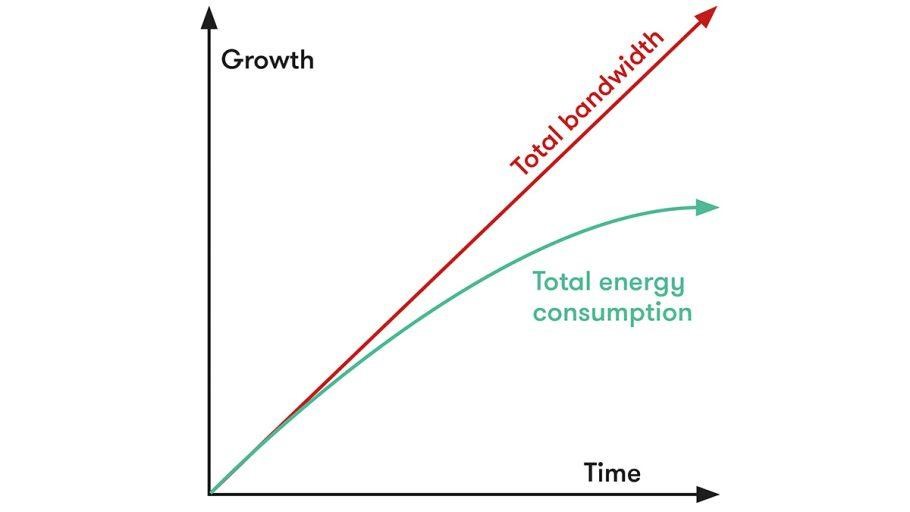How energy efficiency, reduced carbon footprints and an optimized submarine cable lifecycle contribute to sustainability
By Brian Lavallée, Senior Director, Submarine Network Solutions, Ciena
Some may think that most of the world’s connectivity takes place via satellites — that when you send a text or download a file, there is an intricate web of signals and connections taking place far overhead. In reality, across the globe, more than 400 submarine cables lie on seabeds, carrying over 99% of all intercontinental communications traffic. These submarine cables are the backbone of the Internet, and as more and more of the world demands faster, more reliable connectivity, demand — and utter dependence — on these cables will only grow. In fact, the submarine cable system market in the Asia Pacific (APAC) is expected to grow to US$546.78 million by 2028. Governments across the region are already doubling down on submarine cables. Singapore, for instance, aims to double its submarine cable landing sites by 2023 as part of its Digital Connectivity Blueprint.
But this rapid growth does not come without caveats. For submarine cables to transport data successfully over transpacific routes, optical amplifiers are spaced every 80 kilometers, approximately, to boost optical signal power. Submarine Line Terminal Equipment (SLTE), situated on land, houses modems that transmit and receive information over submarine cable networks. Undersea optical amplifiers and terrestrial SLTE are electrically powered, creating a carbon footprint to be optimized.
Clearly, submarine cables are the vascular network of intercontinental connectivity across the globe. And as the world grows more connected, submarine cable networks will only increase in scale and importance. So, what can be done to ensure this growth happens responsibly and sustainably?
Carbon Footprint Cannot Scale Linearly With Bandwidth Growth
According to TeleGeography, global international bandwidth growth has reached 23% in 2023. In Asia, this growth has been faster than the global average, increasing by 32%. With no Plan B on the horizon to replace submarine cable networks, the industry must continually innovate to meet the unique challenges of submarine networks and their much longer distances. The carbon footprint of submarine cable networks that address this ongoing growth in bandwidth demand simply cannot scale linearly in terms of electrical consumption from social, economic and environmental perspectives. Instead, bandwidth must outpace energy demands, meaning that every submarine cable must provide much more capacity than the energy it consumes.
For the telco industry, this can be addressed from three main angles: energy efficiency, carbon footprint and lifecycle.
- Energy Efficiency
To ensure that global bandwidth growth doesn’t linearly scale with the electrical energy required to power submarine networks that carry this telecom traffic, we must “bend the curve,” so the incurred carbon footprint grows at a slower rate than its associated bandwidth. However, simply “bending” this curve may not be sufficient if the goal is to reduce the total energy consumed by submarine cable networks. If the energy consumption curve isn’t bent at a higher rate than total bandwidth growth, the carbon footprint will continue to increase over time, albeit at a slower pace.

Figure 1: Bending the curve of bandwidth growth vs. associated electrical energy consumption
Ongoing SLTE and undersea wet plant technology advances continue unabated, with each new generation providing improved energy efficiency alongside bandwidth improvements to address ongoing growth in demand. New submarine cables based on Spatial Division Multiplexing (SDM) are being deployed, offering significant improvements in electrical energy consumption per transmitted bit by enabling total information-carrying cable capacities well into the hundreds of terabits per second. This capacity is orders of magnitude greater than the first submarine cables based on EDFA optical amplification and DWDM technologies.
- Carbon Footprint
The carbon footprint of any submarine cable network will include the manufacturing, installation, operation, maintenance and retirement lifecycle phases. The operating phase, in particular, involves the ongoing electrical energy consumption of the end-to-end submarine cable network. By using the latest semiconductor technology, significant reductions in electrical energy consumption are achievable.
- Lifecycle
Upgrading existing submarine cables is the best and easiest method to extend their life, and this practice has been happening for over a decade since revolutionary new coherent optical transmission technology was adopted and adapted from terrestrial networks to submarine cable networks. Initially, it allowed submarine cable operators to upgrade existing 10 Gb/s channels to 40 Gb/s channels rapidly and cost-effectively, with no changes required to the existing wet plant. This shift led to massive increases in the total information-carrying capacities of submarine cables that significantly surpassed the original design total capacities based on IMDD (Intensity Modulation Direct Detect) optical transmission technology, which essentially turned light on and off to represent digital ones (light on) and zeros (light off).
The timing of coherent detection optical transmission was perfect because IMDD optical transmission reached its limits — the total submarine cable capacity was fixed just as the Internet adoption rates surged worldwide. This demand would’ve created undersea network bandwidth bottlenecks. Each new generation of coherent optical transmission technology results in ongoing increases in total submarine cable bandwidth, albeit less and less as we reach the Shannon Capacity Limit. To “sidestep” this limit, new SDM wet plants are being deployed, improving the lifecycle of undersea assets by enabling unprecedented total capacities in the hundreds of terabits per second.
Electrical Energy Consumption: A Critical Design Goal
Continual SLTE innovation has significantly improved the spectral efficiency of submarine cable networks by enabling more capacity over the same submarine fiber. This structure means that to improve spectral and electrical energy efficiency over time, technological innovation must occur in the SLTE. This approach will provide reductions in the cost per transmitted bit and savings in electrical energy per bit for a reduced carbon footprint per bit.
The benefit of continually driving down the electrical energy consumption of submarine cable networks has shifted from reducing operating expenditures around electrical energy consumption to saving the planet by reducing carbon footprints. While both are critically important, the latter demands particular attention given our climate change realities. After all, sustainability is not a nice-to-have; it’s a necessity, as the health of our planet depends on it.
There’s no “Plan B” for critical submarine network infrastructure because no other known network technology can cost-effectively replace the vast amounts of data submarine cable networks carry between continents on a similar scale. These space-based network constellations will complement, but not replace, submarine cable networks. Consequently, existing submarine cable network technology must continue to evolve.










